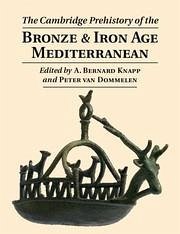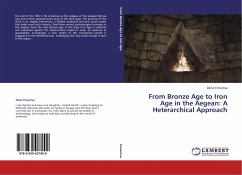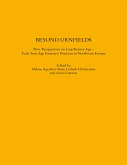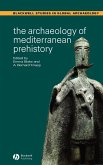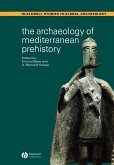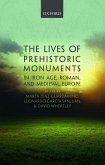The Cambridge Prehistory of the Bronze and Iron Age Mediterranean
Herausgeber: Knapp, A Bernard; Dommelen, Peter Van
The Cambridge Prehistory of the Bronze and Iron Age Mediterranean
Herausgeber: Knapp, A Bernard; Dommelen, Peter Van
- Gebundenes Buch
- Merkliste
- Auf die Merkliste
- Bewerten Bewerten
- Teilen
- Produkt teilen
- Produkterinnerung
- Produkterinnerung
The Cambridge Prehistory of the Bronze and Iron Age Mediterranean explores contemporary archaeology of the Mediterranean region during the Bronze and Iron Ages.
Andere Kunden interessierten sich auch für
![From Bronze Age to Iron Age in the Aegean: A Heterarchical Approach From Bronze Age to Iron Age in the Aegean: A Heterarchical Approach]() Deniz EnverovaFrom Bronze Age to Iron Age in the Aegean: A Heterarchical Approach40,99 €
Deniz EnverovaFrom Bronze Age to Iron Age in the Aegean: A Heterarchical Approach40,99 €![Beyond Urnfields - New Perspectives on Late Bronze Age - Early Iron Age Funerary Practices in Northwest Europe Beyond Urnfields - New Perspectives on Late Bronze Age - Early Iron Age Funerary Practices in Northwest Europe]() Beyond Urnfields - New Perspectives on Late Bronze Age - Early Iron Age Funerary Practices in Northwest Europe59,00 €
Beyond Urnfields - New Perspectives on Late Bronze Age - Early Iron Age Funerary Practices in Northwest Europe59,00 €![The Archaeology of Mediterranean Prehistory The Archaeology of Mediterranean Prehistory]() EMMA BLAKE / A. BERNARD KNAPPThe Archaeology of Mediterranean Prehistory156,99 €
EMMA BLAKE / A. BERNARD KNAPPThe Archaeology of Mediterranean Prehistory156,99 €![The Archaeology of Mediterranean Prehistory The Archaeology of Mediterranean Prehistory]() EMMA BLAKE / A. BERNARD KNAPPThe Archaeology of Mediterranean Prehistory73,99 €
EMMA BLAKE / A. BERNARD KNAPPThe Archaeology of Mediterranean Prehistory73,99 €![The Lives of Prehistoric Monuments in Iron Age, Roman, and Medieval Europe The Lives of Prehistoric Monuments in Iron Age, Roman, and Medieval Europe]() The Lives of Prehistoric Monuments in Iron Age, Roman, and Medieval Europe155,99 €
The Lives of Prehistoric Monuments in Iron Age, Roman, and Medieval Europe155,99 €![Riversides: Neolithic Barrows, a Beaker Grave, Iron Age and Anglo-Saxon Burials and Settlement at Trumpington, Cambridge Riversides: Neolithic Barrows, a Beaker Grave, Iron Age and Anglo-Saxon Burials and Settlement at Trumpington, Cambridge]() Christopher EvansRiversides: Neolithic Barrows, a Beaker Grave, Iron Age and Anglo-Saxon Burials and Settlement at Trumpington, Cambridge64,99 €
Christopher EvansRiversides: Neolithic Barrows, a Beaker Grave, Iron Age and Anglo-Saxon Burials and Settlement at Trumpington, Cambridge64,99 €![The Iron Age Settlement of Arctic Norway The Iron Age Settlement of Arctic Norway]() Thorleif SjøvoldThe Iron Age Settlement of Arctic Norway38,99 €
Thorleif SjøvoldThe Iron Age Settlement of Arctic Norway38,99 €-
-
-
The Cambridge Prehistory of the Bronze and Iron Age Mediterranean explores contemporary archaeology of the Mediterranean region during the Bronze and Iron Ages.
Hinweis: Dieser Artikel kann nur an eine deutsche Lieferadresse ausgeliefert werden.
Hinweis: Dieser Artikel kann nur an eine deutsche Lieferadresse ausgeliefert werden.
Produktdetails
- Produktdetails
- Verlag: Cambridge University Press
- Seitenzahl: 700
- Erscheinungstermin: 12. Januar 2015
- Englisch
- Abmessung: 287mm x 225mm x 48mm
- Gewicht: 2164g
- ISBN-13: 9780521766883
- ISBN-10: 0521766885
- Artikelnr.: 41608662
- Herstellerkennzeichnung
- Libri GmbH
- Europaallee 1
- 36244 Bad Hersfeld
- gpsr@libri.de
- Verlag: Cambridge University Press
- Seitenzahl: 700
- Erscheinungstermin: 12. Januar 2015
- Englisch
- Abmessung: 287mm x 225mm x 48mm
- Gewicht: 2164g
- ISBN-13: 9780521766883
- ISBN-10: 0521766885
- Artikelnr.: 41608662
- Herstellerkennzeichnung
- Libri GmbH
- Europaallee 1
- 36244 Bad Hersfeld
- gpsr@libri.de
1. A little history of Mediterranean island prehistory; 2. Inside out?
Materiality and connectivity in the Aegean archipelago; 3. Early island
exploitations: productive and subsistence strategies on the prehistoric
Balearic Islands; 4. Islands and mobility: exploring Bronze Age
connectivity in the South-Central Mediterranean; 5. Sicily in Mediterranean
history in the second millennium BC; 6. Late Bronze Age Sardinia:
acephalous cohesion; 7. Corridors and colonies: comparing fourth-third
millennia BC interactions in Southeast Anatolia and the Levant; 8. The
Anatolian context of philia material culture in Cyprus; 9. Bronze Age
European elites: from the Aegean to the Adriatic, and back again; 10.
Greece in the Early Iron Age: mobility, commodities, polities, and
literacy; 11. Before 'the gates of Tartessos': indigenous knowledge and
exchange networks in the Late Bronze Age far west; 12. Colonizations and
cultural developments in the central Mediterranean; 13. The Iron Age in
South Italy: settlement, mobility, and culture contact; 14. Migration,
hybridization, and resistance: identity dynamics in the Early Iron Age
Southern Levant; 15. Cultural interactions in Iron Age Sardinia; 16. Myth
into art: foreign impulses and local responses in archaic Cypriot
sanctuaries; 17. Mobility, interaction, and power in the Iron Age Western
Mediterranean; 18. Sensuous memory, materiality, and history: rethinking
the 'rise of the palaces' on Bronze Age Crete; 19. Beyond iconography:
meaning-making in Late Bronze Age Eastern Mediterranean visual and material
culture; 20. Changes in perceptions of the 'other' and expressions of
Egyptian self-identity in the Late Bronze Age; 21. The lure of the
artifact? The effects of acquiring Eastern Mediterranean material culture;
22. Stone worlds: technologies of rock-carving and place-making in
Anatolian landscapes; 23. Rethinking the late Cypriot built environment:
households and communities as places of social transformation; 24.
Households, hierarchies, territories, and landscapes in Bronze Age and Iron
Age Greece; 25. Connectivity beyond the urban community in central Italy;
26. Long term social change in Iron Age northern Iberia (ca.700-200 BC);
27. Who lives there? Settlements, houses, and households in Iberia; 28.
Landscapes and seascapes of Southwest Iberia in the first millennium BC;
29. Domestic and settlement organization in Iron Age Southern France; 30.
Beyond the general and the particular: rethinking death, memory, and
belonging in Early Bronze Age Crete; 31. From the nineteenth century to the
twenty-first: understanding the Bronze argaric lifecourse in the
Mediterranean 'far west'; 32. Crossing borders: death and life in second
millennium BC southern Iberia and North Africa; 33. An entangled past:
island interactions, mortuary practices, and the negotiation of identities
on Early Iron Age Cyprus; 34. The violence of symbols: ideologies,
identity, and cultural interaction in central Italian cemeteries; 35. The
Early Bronze Age Southern Levant: the ideology of an aniconic reformation;
36. Ritual as the setting for contentious interaction: from social
negotiation to institutionalized authority in Bronze Age Cyprus; 37. Cult
activities among central and north Italian protohistoric communities; 38.
Ritual and ideology in Early Iron Age Crete: the role of the past and the
east.
Materiality and connectivity in the Aegean archipelago; 3. Early island
exploitations: productive and subsistence strategies on the prehistoric
Balearic Islands; 4. Islands and mobility: exploring Bronze Age
connectivity in the South-Central Mediterranean; 5. Sicily in Mediterranean
history in the second millennium BC; 6. Late Bronze Age Sardinia:
acephalous cohesion; 7. Corridors and colonies: comparing fourth-third
millennia BC interactions in Southeast Anatolia and the Levant; 8. The
Anatolian context of philia material culture in Cyprus; 9. Bronze Age
European elites: from the Aegean to the Adriatic, and back again; 10.
Greece in the Early Iron Age: mobility, commodities, polities, and
literacy; 11. Before 'the gates of Tartessos': indigenous knowledge and
exchange networks in the Late Bronze Age far west; 12. Colonizations and
cultural developments in the central Mediterranean; 13. The Iron Age in
South Italy: settlement, mobility, and culture contact; 14. Migration,
hybridization, and resistance: identity dynamics in the Early Iron Age
Southern Levant; 15. Cultural interactions in Iron Age Sardinia; 16. Myth
into art: foreign impulses and local responses in archaic Cypriot
sanctuaries; 17. Mobility, interaction, and power in the Iron Age Western
Mediterranean; 18. Sensuous memory, materiality, and history: rethinking
the 'rise of the palaces' on Bronze Age Crete; 19. Beyond iconography:
meaning-making in Late Bronze Age Eastern Mediterranean visual and material
culture; 20. Changes in perceptions of the 'other' and expressions of
Egyptian self-identity in the Late Bronze Age; 21. The lure of the
artifact? The effects of acquiring Eastern Mediterranean material culture;
22. Stone worlds: technologies of rock-carving and place-making in
Anatolian landscapes; 23. Rethinking the late Cypriot built environment:
households and communities as places of social transformation; 24.
Households, hierarchies, territories, and landscapes in Bronze Age and Iron
Age Greece; 25. Connectivity beyond the urban community in central Italy;
26. Long term social change in Iron Age northern Iberia (ca.700-200 BC);
27. Who lives there? Settlements, houses, and households in Iberia; 28.
Landscapes and seascapes of Southwest Iberia in the first millennium BC;
29. Domestic and settlement organization in Iron Age Southern France; 30.
Beyond the general and the particular: rethinking death, memory, and
belonging in Early Bronze Age Crete; 31. From the nineteenth century to the
twenty-first: understanding the Bronze argaric lifecourse in the
Mediterranean 'far west'; 32. Crossing borders: death and life in second
millennium BC southern Iberia and North Africa; 33. An entangled past:
island interactions, mortuary practices, and the negotiation of identities
on Early Iron Age Cyprus; 34. The violence of symbols: ideologies,
identity, and cultural interaction in central Italian cemeteries; 35. The
Early Bronze Age Southern Levant: the ideology of an aniconic reformation;
36. Ritual as the setting for contentious interaction: from social
negotiation to institutionalized authority in Bronze Age Cyprus; 37. Cult
activities among central and north Italian protohistoric communities; 38.
Ritual and ideology in Early Iron Age Crete: the role of the past and the
east.
1. A little history of Mediterranean island prehistory; 2. Inside out?
Materiality and connectivity in the Aegean archipelago; 3. Early island
exploitations: productive and subsistence strategies on the prehistoric
Balearic Islands; 4. Islands and mobility: exploring Bronze Age
connectivity in the South-Central Mediterranean; 5. Sicily in Mediterranean
history in the second millennium BC; 6. Late Bronze Age Sardinia:
acephalous cohesion; 7. Corridors and colonies: comparing fourth-third
millennia BC interactions in Southeast Anatolia and the Levant; 8. The
Anatolian context of philia material culture in Cyprus; 9. Bronze Age
European elites: from the Aegean to the Adriatic, and back again; 10.
Greece in the Early Iron Age: mobility, commodities, polities, and
literacy; 11. Before 'the gates of Tartessos': indigenous knowledge and
exchange networks in the Late Bronze Age far west; 12. Colonizations and
cultural developments in the central Mediterranean; 13. The Iron Age in
South Italy: settlement, mobility, and culture contact; 14. Migration,
hybridization, and resistance: identity dynamics in the Early Iron Age
Southern Levant; 15. Cultural interactions in Iron Age Sardinia; 16. Myth
into art: foreign impulses and local responses in archaic Cypriot
sanctuaries; 17. Mobility, interaction, and power in the Iron Age Western
Mediterranean; 18. Sensuous memory, materiality, and history: rethinking
the 'rise of the palaces' on Bronze Age Crete; 19. Beyond iconography:
meaning-making in Late Bronze Age Eastern Mediterranean visual and material
culture; 20. Changes in perceptions of the 'other' and expressions of
Egyptian self-identity in the Late Bronze Age; 21. The lure of the
artifact? The effects of acquiring Eastern Mediterranean material culture;
22. Stone worlds: technologies of rock-carving and place-making in
Anatolian landscapes; 23. Rethinking the late Cypriot built environment:
households and communities as places of social transformation; 24.
Households, hierarchies, territories, and landscapes in Bronze Age and Iron
Age Greece; 25. Connectivity beyond the urban community in central Italy;
26. Long term social change in Iron Age northern Iberia (ca.700-200 BC);
27. Who lives there? Settlements, houses, and households in Iberia; 28.
Landscapes and seascapes of Southwest Iberia in the first millennium BC;
29. Domestic and settlement organization in Iron Age Southern France; 30.
Beyond the general and the particular: rethinking death, memory, and
belonging in Early Bronze Age Crete; 31. From the nineteenth century to the
twenty-first: understanding the Bronze argaric lifecourse in the
Mediterranean 'far west'; 32. Crossing borders: death and life in second
millennium BC southern Iberia and North Africa; 33. An entangled past:
island interactions, mortuary practices, and the negotiation of identities
on Early Iron Age Cyprus; 34. The violence of symbols: ideologies,
identity, and cultural interaction in central Italian cemeteries; 35. The
Early Bronze Age Southern Levant: the ideology of an aniconic reformation;
36. Ritual as the setting for contentious interaction: from social
negotiation to institutionalized authority in Bronze Age Cyprus; 37. Cult
activities among central and north Italian protohistoric communities; 38.
Ritual and ideology in Early Iron Age Crete: the role of the past and the
east.
Materiality and connectivity in the Aegean archipelago; 3. Early island
exploitations: productive and subsistence strategies on the prehistoric
Balearic Islands; 4. Islands and mobility: exploring Bronze Age
connectivity in the South-Central Mediterranean; 5. Sicily in Mediterranean
history in the second millennium BC; 6. Late Bronze Age Sardinia:
acephalous cohesion; 7. Corridors and colonies: comparing fourth-third
millennia BC interactions in Southeast Anatolia and the Levant; 8. The
Anatolian context of philia material culture in Cyprus; 9. Bronze Age
European elites: from the Aegean to the Adriatic, and back again; 10.
Greece in the Early Iron Age: mobility, commodities, polities, and
literacy; 11. Before 'the gates of Tartessos': indigenous knowledge and
exchange networks in the Late Bronze Age far west; 12. Colonizations and
cultural developments in the central Mediterranean; 13. The Iron Age in
South Italy: settlement, mobility, and culture contact; 14. Migration,
hybridization, and resistance: identity dynamics in the Early Iron Age
Southern Levant; 15. Cultural interactions in Iron Age Sardinia; 16. Myth
into art: foreign impulses and local responses in archaic Cypriot
sanctuaries; 17. Mobility, interaction, and power in the Iron Age Western
Mediterranean; 18. Sensuous memory, materiality, and history: rethinking
the 'rise of the palaces' on Bronze Age Crete; 19. Beyond iconography:
meaning-making in Late Bronze Age Eastern Mediterranean visual and material
culture; 20. Changes in perceptions of the 'other' and expressions of
Egyptian self-identity in the Late Bronze Age; 21. The lure of the
artifact? The effects of acquiring Eastern Mediterranean material culture;
22. Stone worlds: technologies of rock-carving and place-making in
Anatolian landscapes; 23. Rethinking the late Cypriot built environment:
households and communities as places of social transformation; 24.
Households, hierarchies, territories, and landscapes in Bronze Age and Iron
Age Greece; 25. Connectivity beyond the urban community in central Italy;
26. Long term social change in Iron Age northern Iberia (ca.700-200 BC);
27. Who lives there? Settlements, houses, and households in Iberia; 28.
Landscapes and seascapes of Southwest Iberia in the first millennium BC;
29. Domestic and settlement organization in Iron Age Southern France; 30.
Beyond the general and the particular: rethinking death, memory, and
belonging in Early Bronze Age Crete; 31. From the nineteenth century to the
twenty-first: understanding the Bronze argaric lifecourse in the
Mediterranean 'far west'; 32. Crossing borders: death and life in second
millennium BC southern Iberia and North Africa; 33. An entangled past:
island interactions, mortuary practices, and the negotiation of identities
on Early Iron Age Cyprus; 34. The violence of symbols: ideologies,
identity, and cultural interaction in central Italian cemeteries; 35. The
Early Bronze Age Southern Levant: the ideology of an aniconic reformation;
36. Ritual as the setting for contentious interaction: from social
negotiation to institutionalized authority in Bronze Age Cyprus; 37. Cult
activities among central and north Italian protohistoric communities; 38.
Ritual and ideology in Early Iron Age Crete: the role of the past and the
east.

